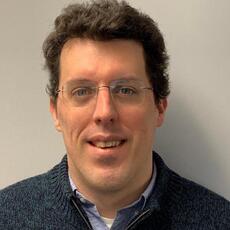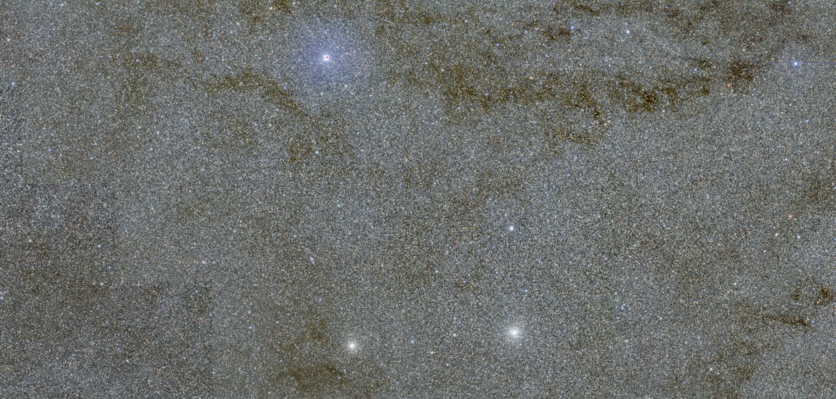
This article was originally published on October 26, 2020.
With everything happening in the world, sometimes it’s important to put your chin up — but not to look at the bright side; it’s more about finding peace while gazing at the night sky. At least, that’s how Astronomy Associate Professor Will Clarkson sees it.
“It’s profoundly beautiful and should be enjoyed,” he says. “The physical universe keeps going no matter what we do. It really is inspirational in a way.”

Clarkson knows a bit about the universe’s vastness. He has spent much of the last decade working as part of a group of leading researchers to assemble an extensive map of the inner regions of the Milky Way galaxy — the Galactic Bulge — comprising a quarter of a billion objects measured in six “filters” ranging from the near-infrared, through the visible part of the spectrum and even a little into the near-ultraviolet.
Led by R. Michael Rich of UCLA and Christian Johnson at the Space Telescope Science Institute, the work involves an evolving team of about 20 researchers from all over the globe, of which Clarkson is a core member.
Historically it's been hard to study the Milky Way’s Galactic Bulge due to vertically thick density of stars and dust and the sheer scale of the structure. A uniform dataset over such a large structure is challenging because high-quality, high-resolution images have tended to be difficult to achieve over large areas of the sky, particularly from the ground. But advances in technology have made it possible.
So the team of researchers set out to establish a legacy dataset of the Milky Way Galactic Bulge — a visual encyclopedia with space object images, spectra, location and more — for astronomers, educators and researchers around the world to use in their work. The team is currently working on quality control for this large dataset and anticipates releasing it to the community during 2021.
“Astronomy is increasingly dominated by large teams of researchers, but this work shows how much impact a relatively small team can have on the analysis of this huge dataset,” Rich says. “This dataset is a taste of things to come in two or three years, when the Vera Rubin Telescope in Chile starts its big surveys.” The observatory, expected to open next year, will specialize in astronomical surveys.
Clarkson says sharing data has become a vital component of astronomical research, with many discoveries now made by re-investigating previously collected datasets.
Public hosting of datasets for others to use for their own scientific purposes has led to an increase in access to scientific discovery by individuals and institutions everywhere. For example, in 2019 more than half the scientific publications resulting from Hubble data were based partly or entirely on archival datasets. “It is a big universe. There are simply too many interesting things for one person to find or solve,” he says. “There is a public spiritedness in this, but it’s also grounded in reality. Collaboration is needed to better understand the universe.”

To gather the images needed to create the Milky Way’s Galactic Bulge dataset, team members — including Clarkson — traveled to South America to use the Dark Energy Survey Camera (DECam) at Chile’s Cerro Tololo Inter-American Observatory on multiple occasions. Attached to the Victor Blanco 4m telescope, the DECam is roughly the size of a Smart Car. “It combines exquisite image quality with a huge field of view, enabling millions of stars to be captured in a single image.” To get an idea of the scope, Clarkson shares that a single image will record data from an area of the sky over four times the diameter of the full moon as seen from Earth.
For this decade-long endeavor, Clarkson says UM-Dearborn students have played an active role too, gaining research experience and skills.
Some examples: Lizzy Clyne, ‘15, was the first UM-Dearborn undergraduate to assist with the images from this project — she later worked with NASA’s jet propulsion team and is now a Ph.D. candidate at Penn State. Brittany Howard, ‘17, worked on quality control of an earlier version of the catalog and traveled with Clarkson in 2015 for an observing run at CTIO for this project. After completing a Masters’ in Astrophysics at the University of Victoria, Howard is now a data scientist in the private sector. Currently, seniors Alexis Osmond and Nick Boyd work with Clarkson to examine the galactic objects in the DECam images and properly characterize and catalog them.
Osmond says her interest in astrophysics enticed her to apply for a research assistant position in Clarkson’s lab. But the importance of the work is what has kept her in that role for the majority of her time as an undergrad.
“My part of the work uses data from the Gaia spacecraft to check the camera distortion. I saw this Gaia data release mentioned in one of the astronomy textbooks, which is what put everything into perspective and helped me realize how the work I was doing would be applied in the real world,” says Osmond, a physics major. “I had the opportunity to present my astrometric calibration of the catalog using Gaia DR2 at the Conference for Undergraduate Women in Physics, which was a great chance to meet other physicists and to get to know more about physics as a profession. I’m looking forward to applying this to Gaia DR3 when it’s released.”
And Boyd says working with never-seen-before images strengthens his interest in discovery. “I’ve always been interested in space. You can’t help but look up at the night sky and wonder what’s going on up there. I really like being able to find out something that wasn’t previously known,” says Boyd, who says his work in Clarkson’s lab, like calibrating an X-ray spectrum detector, gave him the experience needed for his summer internship at Stanford’s National Accelerator Laboratory. “There’s still more to learn, of course, but we are creating a map for researchers to use now and into the future.”
Clarkson says having the legacy dataset opens the door for significant discoveries.
“We are hopeful that the map will ultimately unlock some of the deepest mysteries about the formation of our own galaxy, and therefore help us understand galaxy formation throughout the universe.”
The research team involved with this project: R. Michael Rich (University of California, Los Angeles), Christian I. Johnson (Space Telescope Science Institute), Michael Young (Indiana University), Iulia T. Simion (Shanghai Astronomical Observatory), William I. Clarkson (University of Michigan-Dearborn), Catherine Pilachowski (Indiana University), Scott Michael (Indiana University), Andrea Kunder (St Martin’s University), A. Katherina Vivas (NSF’s NOIRLab), Andreas Koch (University of Heidelberg), Tommaso Marchetti (European Southern Observatory), Rodrigo Ibata (Strasbourg Observatory), Nicolas Martin (Strasbourg Observatory), Annie C. Robin (University of Bourgogne Franche-Comté), Nadége Lagarde (University of Bourgogne Franche-Comté), Michelle Collins (University of Surrey), Željko Ivezic (University of Washington), Roberto de Propris (Finnish Centre for Astronomy with ESO), and Juntai Shen (Shanghai Jiao Tong University).




